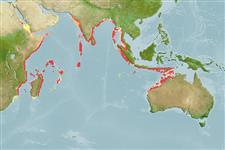Environment: milieu / climate zone / depth range / distribution range
Sinh thái học
Biển; Nước ngọt; Thuộc về nước lợ Sống nổi và đáy; Di cư sông biển (để đẻ trứng) (Ref. 51243). Tropical; 23°N - 33°S
Asia: Pakistan, India, Sri Lanka, Burma, and the East Indies. Reported from Nepal (Ref. 9496, 12045) and Bangladesh (Ref. 1479).
Bộ gần gũi / Khối lượng (Trọng lượng) / Age
Maturity: Lm ? range ? - ? cm
Max length : 200 cm TL con đực/không giới tính; (Ref. 85009); common length : 80.0 cm TL con đực/không giới tính; (Ref. 4832); Khối lượng cực đại được công bố: 6.0 kg (Ref. 1479)
Các vây lưng mềm (tổng cộng) : 250 - 305; Tia mềm vây hậu môn: 220 - 250; Động vật có xương sống: 106 - 112. Body elongate, head conical, flattened dorsally. Mouth terminal, lips prominent, narrow bands of teeth on jaws, broad band on vomer.
Lives in freshwaters, but also occurs in estuaries and in the sea during early life and near maturity (Ref. 4832). Occurs in freshwater streams, pools and reservoirs and commonly found in mud substrates of tanks and in deep rock pools of rivers (Ref. 41236). Most common eel in Indian inland waters. There exists a good export market for both live elvers and eels. Highly prized as food fish because of its nutritional value. Fish mucous from live fish mixed with rice or wheat flour is used as medicine for arthritis (Ref. 44150).
Life cycle and mating behavior
Chín muồi sinh dục | Sự tái sinh sản | Đẻ trứng | Các trứng | Sự sinh sản | Ấu trùng
Talwar, P.K. and A.G. Jhingran, 1991. Inland fishes of India and adjacent countries. vol 1. A.A. Balkema, Rotterdam. i-liv + 1-541, 1 map (Ref. 4832)
IUCN Red List Status (Ref. 130435: Version 2024-2)
Threat to humans
Harmless
Human uses
Các nghề cá: Tính thương mại; Nuôi trồng thủy sản: Giống như cách dùng trong tương lai; cá để chơi: đúng
Các công cụ
Special reports
Download XML
Các nguồn internet
Estimates based on models
Preferred temperature (Ref.
123201): 26.2 - 29.3, mean 28.3 °C (based on 292 cells).
Phylogenetic diversity index (Ref.
82804): PD
50 = 0.5000 [Uniqueness, from 0.5 = low to 2.0 = high].
Bayesian length-weight: a=0.00076 (0.00037 - 0.00157), b=3.17 (3.00 - 3.34), in cm total length, based on LWR estimates for this Genus-body shape (Ref.
93245).
Mức dinh dưỡng (Ref.
69278): 3.8 ±0.7 se; based on size and trophs of closest relatives
Thích nghi nhanh (Ref.
120179): Rất thấp, thời gian nhân đôi của chủng quần tối thiểu là hơn 14 năm (Preliminary K or Fecundity.).
Fishing Vulnerability (Ref.
59153): Very high vulnerability (90 of 100).
Nutrients (Ref.
124155): Calcium = 25.7 [12.9, 56.8] mg/100g; Iron = 0.5 [0.3, 0.9] mg/100g; Protein = 18.2 [16.3, 20.3] %; Omega3 = 0.246 [0.109, 0.567] g/100g; Selenium = 184 [71, 424] μg/100g; VitaminA = 20.6 [3.6, 106.6] μg/100g; Zinc = 0.956 [0.596, 1.561] mg/100g (wet weight);
